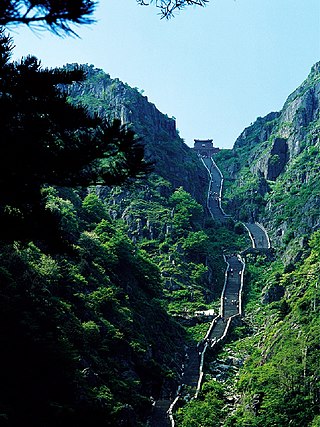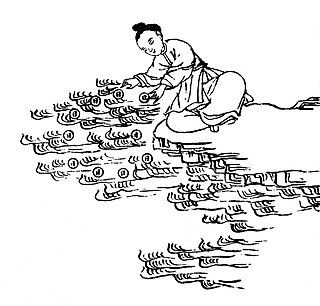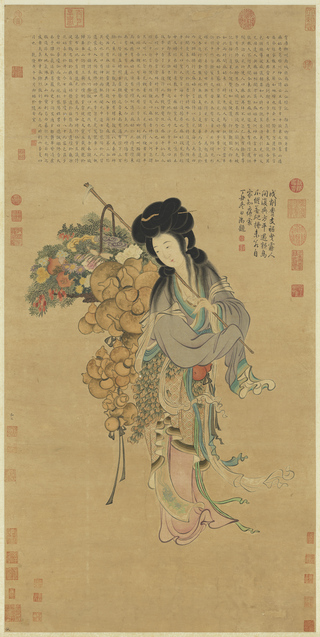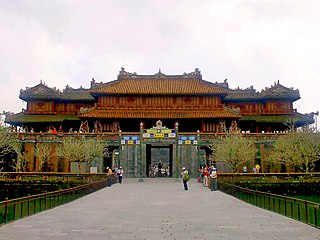Related Research Articles

Chengyu are a type of traditional Chinese idiomatic expressions, most of which consist of four Chinese characters. Chengyu were widely used in Literary Chinese and are still common in written vernacular Chinese writing and in the spoken language today. According to the most stringent definition, there are about 5,000 chengyu in the Chinese language, though some dictionaries list over 20,000. Chengyu are considered the collected wisdom of the Chinese culture, and contain the experiences, moral concepts, and admonishments from previous generations of Chinese speakers. Chengyu still play an important role in Chinese conversation and education. Chinese idioms are one of four types of formulaic expressions, which also include collocations, two-part allegorical sayings called xiehouyu, and proverbs.

The Nguyễn dynasty was the last Vietnamese dynasty, which was preceded by the Nguyễn lords and ruled the unified Vietnamese state independently from 1802 to 1883 before being a French protectorate. During its existence, the empire expanded into modern-day southern Vietnam, Cambodia, and Laos through a continuation of the centuries-long Nam tiến and Siamese–Vietnamese wars. With the French conquest of Vietnam, the Nguyễn dynasty was forced to give up sovereignty over parts of southern Vietnam to France in 1862 and 1874, and after 1883 the Nguyễn dynasty only nominally ruled the French protectorates of Annam as well as Tonkin. They later cancelled treaties with France and were the Empire of Vietnam for a short time until 25 August 1945.

Mount Tai is a mountain of historical and cultural significance located north of the city of Tai'an. It is the highest point in Shandong province, China. The tallest peak is the Jade Emperor Peak, which is commonly reported as being 1,545 meters (5,069 ft) tall.

The Tale of Kiều is an epic poem in Vietnamese written by Nguyễn Du (1765–1820), well known in Vietnamese literature. The original title in Vietnamese is Đoạn Trường Tân Thanh, but it is better known as Truyện Kiều.
The East Sea, one of the Four Seas, is identified as the body of water east of the mainland according to ancient Chinese geography. In Chinese literature, the Four Seas are a metaphor for the boundaries of China. It contains modern day East China Sea as well as the Yellow Sea and Bohai Sea.

Vietnamese dragons are symbolic creatures in Vietnamese folklore and mythology. According to an ancient origin myth, the Vietnamese people are descended from a dragon and an Immortal. The dragon was symbolic of bringing rain, essential for agriculture. It represents the emperor, the prosperity and power of the nation. Similar to the Chinese dragon, the Vietnamese dragon is the symbol of yang, representing the universe, life, existence, and growth.

A Chinese dictionary is a reference work for the Chinese language. There are two main types of Chinese dictionaries: zidian, which list individual Chinese characters and their definitions, and cidian, which list words and short phrases along with their meanings. Because written Chinese consists of tens of thousands of characters, over time editors of Chinese dictionaries have developed a number of ways to organize them for convenient reference.

Xihe, was a solar deity in Chinese mythology. One of the two wives of Di Jun, she was the mother of ten suns in the form of three-legged crows residing in a mulberry tree, the Fusang, in the East Sea. Each day, one of the sun birds would be rostered to travel around the world on a carriage driven by Xihe.

The Gin, or Jing people, are a community of descendants of ethnic Vietnamese people living in China. They mainly live in an area called the Jing Islands (京族三岛), off the coast of Dongxing, Fangchenggang, in the Chinese autonomous region of Guangxi. These territories were administered by the Nguyễn dynasty but were later ceded by the French to the Qing dynasty due to the 1887 convention, after the Sino-French war.

Đông Bắc is the region to the north of the Red River Delta in Vietnam, bordering China. It is called Northeast to distinguish it from the Tây Bắc or "Northwest", but it is actually in the north and northeast of Hanoi, wider than Việt Bắc or "Northern Vietnam". The Northeast is one of three sub-regions of Northern Vietnam. Sometimes the Northeast includes the Red River Delta.

Magu is a legendary Taoist xian associated with the elixir of life, and a symbolic protector of women in Chinese mythology. Stories in Chinese literature describe Magu as a beautiful young woman with long birdlike fingernails, while early myths associate her with caves. Magu xian shou is a popular motif in Chinese art.
Vietnamese poetry originated in the form of folk poetry and proverbs. Vietnamese poetic structures include Lục bát, Song thất lục bát, and various styles shared with Classical Chinese poetry forms, such as are found in Tang poetry; examples include verse forms with "seven syllables each line for eight lines," "seven syllables each line for four lines", and "five syllables each line for eight lines." More recently there have been new poetry and free poetry.

Vietnamese architecture is the architectural style used by the Vietnamese through the process of historical development and the absorption and integration of regional and international architectures. Vietnamese architecture is reflected in the works from đình, shrines, temples, nhà thờ họ, citadels, palaces and housing architecture.

The Peach Blossom Spring, or Peach Blossom Spring Story or The Peach Blossom Land was a fable written by Tao Yuanming in 421 CE about a chance discovery of an ethereal utopia where the people lead an ideal existence in harmony with nature, unaware of the outside world for centuries. The phrase can be used to describe an idealistic place of beauty and repose, although it is sometimes used to refer to an unrealistic dream.
Duke Jing of Jin was the ruler of the State of Jin, a major power during the Spring and Autumn period of ancient China, from 599 to 581 BC. His ancestral name was Ji, given name Ju and Duke Jing was his posthumous title. He succeeded his father Duke Cheng of Jin, who died in 600 BC.
The Flood Mythology of China, or Great Flood of China is a deluge theme which happened in China. Derk Bodde (1961) stated that "from all mythological themes in ancient Chinese, the earliest and so far most pervasive is about flood." The mythology also has shared characteristics with other Great Floods all over the world, although it also has unique characteristics or different focuses. Lu Yilu (2002) groups all versions of great flood into three themes: "the heroes controls the flood; "brother-sister marriage to repopulating the world"; and "the flood which is drowning the whole city along with its citizens".

Chu is a Daoist name used for various religious practices including communal chu (Kitchen) banquet rituals in Way of the Celestial Masters liturgy, the legendary xingchu associated with Daoist xian, and wuchu representing the wuzang in neidan meditation techniques.
Lijia Dao was one of the oldest schools of religious Daoism and was popular throughout South China during the Six Dynasties (220-589). Lijia dao was founded by Li A. Since several Way of the Li Family practices resembled those of the Way of the Celestial Masters, such as healing with (fu) amulets and holding expensive chu "Kitchen" feasts, the sect is associated with the Southern Celestial Masters. Mainstream Daoist schools denounced the Way of the Li Family as heterodox, particularly for its charlatan healers who claimed extraordinary longevity. For instance, Li Tuo (李脫) or Li Babai and his disciple Li Hong (李弘) were executed in 324 for practicing sorcery and plotting rebellion.

Lishui or shuijiao is a set of parallel diagonal, multicoloured sea-waves/line patterns. It originated in China where it was used by the Qing dynasty court prior to the mid-18th century. Lishui represents the deep sea under which the ocean surges and waves; it is therefore typically topped with "still water", which is represented by concentric semicircle patterns which runs horizontally. Lishui was used to decorate garments, including the bottom hem and cuffs of some of the court clothing of the Qing dynasty. It could be used to decorate as wedding dress items. It is also used to decorate Chinese opera costumes, typically on the bottom hem of the costumes. It was also adopted in some court clothing of the Nguyen dynasty in Vietnam under the influence of the Qing dynasty.

Xitu was the Chinese designation for a historical region or a Chamic polity or kingdom that was first mentioned in the mid of fifth century AD, is believed to be one of the predecessors of Champa Kingdom. It has been proposed to be located in the Thu Bồn River Valley, present-day Quảng Nam Province, Central Vietnam.
References
- 1 2 3 4 Robert F. Campany (2002). To Live as Long as Heaven and Earth: A Translation and Study of Ge Hong's Traditions of Divine Transcendents . California: University of California Press. pp. 261–263. ISBN 978-0-520-92760-5.
- ↑ Minford, John; Lau, Joseph S. M. (2000). Classical Chinese Literature: An Anthology of Translations. Vol. 1. Chinese University Press. pp. 171–172. ISBN 978-962-996-048-3.
- ↑ May, Brian; Tomoda, Takako (2002). "The Story of Dr Huan, Duke Jing and the Shaman from Mulberry Fields". Journal of the Australian Chinese Medicine Education and Research Council. 7 (3).
- 1 2 3 4 "mulberry field". MDBG Chindic. Retrieved 16 November 2015.
- 1 2 3 4 Lu Yongxiang (14 October 2014). A History of Chinese Science and Technology, Volume 1. Shanghai: Shanghai Jiao Tong University Press. pp. 125–126. ISBN 978-3-662-44257-9.
- ↑ Helaine Selin (2013). Encyclopaedia of the History of Science, Technology, and Medicine in Non-Western Cultures. Springer Science & Business Media. p. 1041. ISBN 978-94-017-1416-7.
- ↑ "Chinese Idiom: "沧海桑田"". Tumblr. 17 September 2011. Retrieved 16 November 2015.[ unreliable source? ]
- ↑ C. S. Song (2012). In the Beginning Were Stories, Not Texts. Cambridge: James Clarke & Co. pp. 81–82. ISBN 978-0-227-68023-0.
- ↑ Vera Schwarcz (2014). Place and Memory in the Singing Crane Garden. Filadefia: University of Pennsylvania Press. p. 122. ISBN 978-0-8122-9173-5.
- ↑ Xuan-Lan Nguyen (2009). The Sea and the Mulberry Field. ISBN 978-1-4349-0301-3.